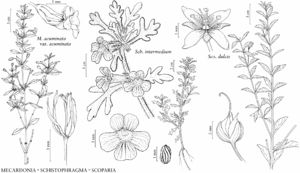Scoparia
Sp. Pl. 1: 116. 1753.
| Taxon | Illustrator ⠉ | |
|---|---|---|
 | Mecardonia acuminata var. acuminata Schistophragma intermedium Scoparia dulcis | Yevonn Wilson-Ramsey John Myers Barbara Alongi |
Herbs [subshrubs], annual or perennial. Stems decumbent, spreading, ascending, or erect, glabrous or puberulent to glandular-puberulent. Leaves cauline, opposite, distal sometimes whorled; petiole absent or nearly so; blade not fleshy, not leathery, margins entire, crenate, dentate, or pinnately lobed, surfaces distinctly punctate. Inflorescences axillary, flowers 1–4 per node; bracts present. Pedicels present, spreading to ascending; bracteoles absent. Flowers bisexual; sepals 4 or 5, proximally connate, calyx radially symmetric, short-campanulate, lobes ovate to elliptic-ovate or lanceolate; corolla white, sometimes tinged pink or lavender, or yellow or orangish yellow, radially symmetric, rotate or subrotate, tube base not spurred or gibbous, throat densely pilose internally, lobes 4; stamens 4, proximally adnate to corolla, subequal, exserted, filaments glabrous; staminode 0; ovary 2-locular, placentation axile; stigma capitate. Fruits capsules, dehiscence septicidal and secondarily loculicidal. Seeds 50–200, brown to dark-brown, oblong or angled, wings absent. × = 10.
Distribution
United States, Mexico, West Indies, Central America, South America, in Asia, Africa, Indian Ocean Islands (Madagascar), Australia
Discussion
Species ca. 10 (2 in the flora).
Selected References
Lower Taxa
Key
| 1 | Corollas white, sometimes tinged pink or lavender; calyx lobes 4. | Scoparia dulcis |
| 1 | Corollas yellow or orangish yellow; calyx lobes 5. | Scoparia montevidensis |